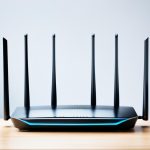Wi-Fi roaming is a crucial process in maintaining a consistent connection while moving between access points (APs). The seamless transition from one AP to another without losing connection is essential for a smooth network experience. To achieve this, various Wi-Fi roaming techniques and technologies come into play.
In this article, we will explore Wi-Fi roaming techniques and discuss how devices and APs play significant roles in ensuring a seamless network transition. Additionally, we will delve into different Wi-Fi roaming methods, their benefits, and the importance of standardization efforts for a more reliable roaming experience. Finally, we will provide some best practices to optimize Wi-Fi roaming for optimal performance.
Join us as we explore the world of Wi-Fi roaming and discover how these techniques can enhance your network connectivity and user experience.
The Role of Devices in Wi-Fi Roaming
Devices play a significant role in the Wi-Fi roaming process, as they are responsible for making decisions about when and where to roam. While the AP can influence the roaming process, it is ultimately the device that determines whether and how to roam.
Factors such as received signal strength, availability of access points on the same network or other networks, and previous connections configured for auto-join are taken into consideration. These factors help the device assess the quality of the current connection and the potential benefits of roaming to another AP.
Roaming optimization support technologies further enhance the Wi-Fi roaming experience. One such technology is radio measurement (802.11k), which allows devices to gather information about neighboring access points and their respective signal strengths. This information helps the device make an informed decision about when to roam to a better access point.
Another technology, fast BSS transition (802.11r), enables devices to transition seamlessly between access points within the same network without reauthentication. This reduces the time required for the roaming process and ensures uninterrupted connectivity.
A third technology, pairwise master key identifier (PMKID) caching, facilitates faster roaming by storing security credentials for previously connected access points. This eliminates the need for repeated authentication, saving time and improving device battery life.
Seamless roaming requires support from both the device and the access point. By leveraging these roaming optimization technologies, devices can enhance their ability to make informed decisions and seamlessly transition between access points, improving overall Wi-Fi roaming performance and user experience.
It’s important for devices to be equipped with these roaming optimization technologies and for access points to support them. This ensures that devices can take full advantage of the features and capabilities offered by the APs, resulting in a smoother and more reliable Wi-Fi roaming experience.
Key Takeaways:
- Devices play a crucial role in determining when and where to roam in a Wi-Fi network.
- Factors such as signal strength and availability of access points influence the device’s roaming decisions.
- Roaming optimization technologies like 802.11k, 802.11r, and PMKID caching enhance roaming performance and device battery life.
- Seamless roaming requires support from both the device and the access point.
Different Wi-Fi Roaming Techniques
There are different techniques to achieve Wi-Fi Roaming. Let’s explore some of these techniques:
Multiple APs with the same SSID
One of the simplest Wi-Fi roaming techniques involves setting up multiple access points (APs) with the same service set identifier (SSID) and security type, but different channels. This configuration allows clients to move around the coverage area and switch between APs without experiencing interruptions in their connections. However, this method relies on the signal degradation of the current connection before switching to a stronger signal. It may not provide seamless handoff for uninterrupted connectivity.
Seamless Handoff
To achieve seamless handoff and uninterrupted connectivity, a feature called “seamless handoff” or “zero-handoff” is required. This feature enables communication between APs, allowing devices to utilize the stronger signal when they are in range of multiple APs without any connection interruptions. Seamless handoff usually requires enterprise-level APs or specific hardware like Ubiquiti APs, which have the capability to maintain continuous communication and provide a seamless roaming experience.
Mesh Wi-Fi Systems
Another Wi-Fi roaming technique involves using mesh Wi-Fi systems. These systems consist of multiple devices that communicate with each other to extend the wireless coverage range. Mesh systems enable seamless roaming by creating a mesh network where devices can move between different access points without experiencing any disruptions in their connections. This approach offers extended coverage with seamless roaming, providing a more reliable and consistent Wi-Fi experience throughout the coverage area.
However, it is important to note that the implementation and support for roaming enhancement technologies may vary among different mesh Wi-Fi systems.
In the next section, we will discuss the standardization efforts and future developments in Wi-Fi roaming.
Standardization and Future Developments
The Wi-Fi Alliance is committed to improving Wi-Fi roaming by implementing standardized solutions. One such initiative is the Wi-Fi CERTIFIED Agile Multiband certification program, which aims to enhance wireless connectivity and address roaming challenges. This certification program includes support for essential roaming enhancement technologies, such as 802.11k, 802.11v, and 802.11r.
This certification ensures that certified Wi-Fi products adhere to a standardized set of roaming enhancements, leading to a more reliable and seamless roaming experience for users. By incorporating these technologies, Wi-Fi networks can optimize their performance and mitigate connection disruptions during roaming transitions.
However, the success of Wi-Fi roaming standardization relies on the industry’s adoption of these certified products. Manufacturers need to invest in the necessary time and resources to implement the certified technologies into their devices. As the industry evolves, we expect to see increasing support for standardized roaming enhancement technologies, further driving the adoption of Wi-Fi CERTIFIED Agile Multiband products.
The future of Wi-Fi roaming holds promising developments, as advancements in Wi-Fi technology continue to shape the industry. There is a growing emphasis on improving real-time services like voice and video, which require seamless network transitions. Innovations in Wi-Fi standards and technologies will aim to tackle these challenges and deliver enhanced roaming experiences.

Benefits of Standardization
Standardizing Wi-Fi roaming brings numerous benefits to users and network operators:
- Improved connectivity: Standardized roaming enhancements ensure a smoother transition between access points, reducing connection disruptions and increasing overall network stability.
- Enhanced user experience: With consistent and reliable roaming experiences, users can seamlessly roam from one access point to another without experiencing interruptions in their online activities.
- Optimized network performance: Standardization allows networks to implement roaming enhancements uniformly, resulting in optimized performance and better utilization of available resources.
- Interoperability: Wi-Fi devices certified with the Wi-Fi CERTIFIED Agile Multiband program offer improved interoperability, allowing users to connect effortlessly to different Wi-Fi networks and access points.
Wi-Fi Roaming Standardization Technologies
| Roaming Enhancement Technologies | Description |
|---|---|
| 802.11k | Delivers radio resource measurements, enabling devices to make informed roaming decisions based on signal strength, available channels, and network conditions. |
| 802.11v | Enables network-assisted roaming, allowing access points to provide roaming recommendations to devices, resulting in faster and more efficient roaming transitions. |
| 802.11r | Facilitates fast BSS (Basic Service Set) transition, reducing the time taken to establish connectivity with a new access point during roaming, minimizing latency and ensuring uninterrupted real-time services. |
Best Practices for Optimal Wi-Fi Roaming
While there are no sure solutions for trouble-free Wi-Fi roaming, implementing best practices can significantly improve your chances of achieving optimal Wi-Fi roaming. By following these recommendations, you can enhance coverage, performance, and user experience. Let’s explore the best practices for seamless and reliable Wi-Fi roaming.
Mult-AP Wi-Fi System Considerations
First and foremost, assess whether a multi-AP Wi-Fi system aligns with your specific requirements. Upgrading your router or deploying a Wi-Fi system can effectively expand coverage and enhance performance. However, it’s crucial to ensure support for key roaming enhancement technologies to facilitate seamless transitions between access points. When evaluating routers or Wi-Fi systems, carefully review the specifications to confirm compatibility with 802.11k, 802.11v, and 802.11r roaming enhancements.
Understanding Roaming Behaviors
A deep understanding of how clients roam and the required signal strength for a candidate access point (AP) is fundamental to designing a wireless network that supports real-time services. Conduct thorough research on your network environment and devices to determine the signal strength thresholds needed for a smooth handoff between APs. By gathering this critical information, you can optimize the placement and configuration of APs, ensuring seamless roaming transitions for your users.
Regular Monitoring and Maintenance
Regular monitoring and maintenance of your Wi-Fi network are essential to optimize roaming performance. Continuously monitor your network’s performance metrics, such as signal strength, latency, and packet loss, to identify any potential bottlenecks or areas of improvement. Also, ensure that all APs and networking equipment are updated with the latest firmware to leverage performance and security enhancements. Routine maintenance activities, such as clearing channel interference or adjusting AP power levels, can further enhance Wi-Fi roaming performance.
By adhering to these best practices, you can maximize the potential for optimal Wi-Fi roaming in your network. While challenges may still arise, implementing these recommendations will significantly improve your network’s ability to provide seamless connectivity and an enhanced user experience.
| Best Practices for Optimal Wi-Fi Roaming |
|---|
| Assess whether a multi-AP Wi-Fi system aligns with your specific requirements. |
| Confirm compatibility with 802.11k, 802.11v, and 802.11r roaming enhancements. |
| Understand roaming behaviors and required signal strength for a candidate AP. |
| Regularly monitor network performance metrics and conduct maintenance activities. |
To further illustrate the importance of these best practices, take a look at the table below, which highlights the essential steps you need to take to achieve optimal Wi-Fi roaming in your network.
Conclusion
Wi-Fi roaming is a complex process, influenced by both devices and access points, that aims to achieve a seamless transition from one AP to another without losing connection. While there are techniques and technologies available to enhance roaming performance, achieving trouble-free Wi-Fi roaming remains a challenge.
Technologies such as seamless handoff and mesh Wi-Fi systems offer potential solutions to improve roaming performance by enabling uninterrupted connectivity. However, it’s important to note that the implementation and support for roaming enhancement technologies can vary.
In an effort to standardize roaming enhancements, the Wi-Fi Alliance has introduced the Wi-Fi CERTIFIED Agile Multiband certification program. This program aims to improve the reliability and consistency of roaming enhancements by ensuring a common set of technologies are implemented in certified products. However, the adoption of this certification program and the investment required from manufacturers remains to be seen.
As the industry progresses, it is crucial to stay informed about the latest advancements and best practices in order to optimize Wi-Fi roaming for a seamless network transition. Regular monitoring and maintenance of your Wi-Fi network, along with upgrading to routers or Wi-Fi systems that support roaming enhancement technologies, can help improve roaming performance. By staying updated and implementing these best practices, you can enhance the reliability and effectiveness of Wi-Fi roaming in your network.
FAQ
What is Wi-Fi roaming?
Wi-Fi roaming is the process of seamlessly moving from one access point (AP) to another without losing connection.
How does the Wi-Fi roaming process work?
The Wi-Fi roaming process involves four steps: looking for roam targets, deciding when to roam, deciding where to roam, and making the move. The station (STA) initiates the roaming process and determines when to roam based on factors like signal level and packet retries.
Can the access point (AP) influence the Wi-Fi roaming process?
Yes, the AP can influence the roaming process by delaying responses, refusing to authenticate a STA, or providing an optimized list of APs to roam to.
Do Wi-Fi systems guarantee seamless roaming?
No, Wi-Fi systems like mesh systems do not guarantee seamless roaming, and support for roaming enhancement technologies can vary.
What role do devices play in the Wi-Fi roaming process?
Devices are responsible for making decisions about when and where to roam. The device determines whether and how to roam based on factors like signal strength, availability of access points, and previous connections configured for auto-join.
How can roaming optimization support technologies improve Wi-Fi roaming?
Roaming optimization support technologies like 802.11k, 802.11r, and PMKID caching can improve roaming performance and device battery life.
What are the different techniques to achieve Wi-Fi roaming?
There are different techniques to achieve Wi-Fi roaming, including setting up multiple APs with the same SSID and security type but different channels, using seamless handoff or zero-handoff features, and using mesh Wi-Fi systems.
What is the Wi-Fi CERTIFIED Agile Multiband certification program?
The Wi-Fi CERTIFIED Agile Multiband certification program is introduced by the Wi-Fi Alliance to standardize roaming enhancements in certified products and provide a more reliable and seamless roaming experience.
How can I improve my chances of successful Wi-Fi roaming?
Some best practices for improving Wi-Fi roaming include considering a multi-AP Wi-Fi system with support for roaming enhancement technologies, checking specifications for support of 802.11k, 802.11v, and 802.11r, designing a wireless network that supports real-time services, and regularly monitoring and maintaining the Wi-Fi network.
Is trouble-free Wi-Fi roaming possible?
While there are no sure solutions for trouble-free Wi-Fi roaming, advancements in Wi-Fi technology and standards are continuously being made to improve the reliability and performance of Wi-Fi roaming.



















